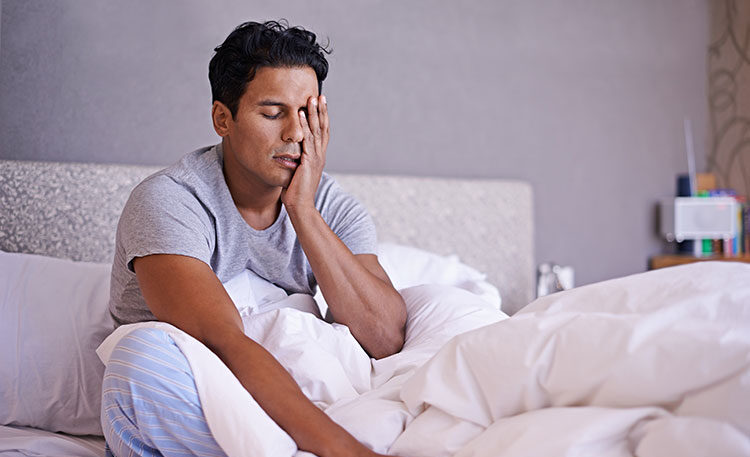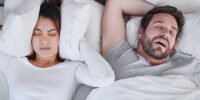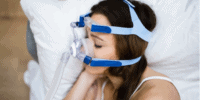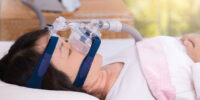How To Recognize The Symptoms Of Sleep Apnea?

Sleep apnea is a prevalent sleep disorder characterized by interrupted breathing during sleep. It affects millions of people worldwide and can have serious health consequences if left untreated. Recognizing the symptoms of sleep apnea is crucial for early diagnosis and treatment.
One prominent symptom of sleep apnea is excessive daytime sleepiness. Individuals with sleep apnea often feel excessively tired during the day, even after a full night’s sleep.
Loud snoring is another common symptom, usually accompanied by gasping or choking sensations during sleep. Morning headaches are also frequently reported by individuals with sleep apnea.
Restless sleep, characterized by frequent awakenings and tossing and turning in bed, is another symptom to look out for. Mood changes and irritability can also be indicators of sleep apnea.
If you or someone you know is experiencing these symptoms, it is important to seek medical evaluation and treatment. Early diagnosis and intervention can help manage the symptoms and improve quality of life for individuals with sleep apnea.
Key Takeaways
- Sleep apnea is a prevalent sleep disorder characterized by interrupted breathing during sleep.
- Symptoms of sleep apnea include excessive daytime sleepiness, loud snoring, gasping or choking sensations during sleep, morning headaches, restless sleep, mood changes, irritability, and difficulty concentrating.
- Sleep apnea can be categorized into three types: obstructive sleep apnea (OSA), central sleep apnea (CSA), and complex sleep apnea syndrome (CSAS).
- Seeking medical evaluation and treatment is essential for managing sleep apnea and improving quality of life.
Understanding Sleep Apnea
Sleep apnea is a sleep disorder characterized by repetitive pauses in breathing during sleep, which can lead to various symptoms and health complications. It is important to understand the condition to recognize its symptoms.
Sleep apnea can be categorized into three types: obstructive sleep apnea (OSA), central sleep apnea (CSA), and complex sleep apnea syndrome (CSAS). OSA is the most common type and occurs when the upper airway becomes blocked, leading to interruptions in breathing. CSA occurs when the brain fails to send proper signals to the muscles controlling breathing. CSAS is a combination of both OSA and CSA.
Common symptoms of sleep apnea include loud snoring, excessive daytime sleepiness, morning headaches, irritability, and difficulty concentrating. It is crucial to recognize these symptoms to seek appropriate medical intervention and improve overall sleep quality and well-being.
Excessive Daytime Sleepiness
Excessive daytime sleepiness, a common manifestation of sleep apnea, can significantly impact an individual’s daily functioning and quality of life. This persistent feeling of drowsiness during the day can result in reduced productivity, impaired concentration, and an increased risk of accidents. It may also lead to difficulties in maintaining personal relationships and participating in social activities.
To emphasize the seriousness of excessive daytime sleepiness, consider the following:
- Individuals may struggle to stay awake during important tasks, such as driving, which can have life-threatening consequences.
- The constant fatigue can lead to feelings of frustration, hopelessness, and depression.
- The inability to stay alert and engaged during social interactions can result in feelings of isolation and a decrease in overall well-being.
Recognizing excessive daytime sleepiness as a symptom of sleep apnea is crucial in seeking timely diagnosis and appropriate treatment, thereby improving the affected individual’s overall health and well-being.
Loud Snoring
Loud snoring, a common auditory manifestation, is often associated with sleep apnea and can disrupt the quality of sleep for both the affected individual and their partner. It is characterized by a harsh, vibrating sound produced during sleep due to the partial obstruction of the upper airway. Although snoring can be a normal phenomenon, it becomes a concern when it is loud, regular, and accompanied by other symptoms of sleep apnea, such as daytime sleepiness and fatigue. The loudness of snoring can vary, but it is typically louder than the usual soft snoring observed in non-apneic individuals. Sleep studies have shown that snoring is present in almost all sleep apnea cases, making it an important clinical sign for diagnosis. The table below summarizes the key characteristics of loud snoring in individuals with sleep apnea.
| Characteristics of Loud Snoring | |
|---|---|
| Loudness | Louder than normal snoring |
| Regularity | Consistent throughout the night |
| Duration | Lasts for more than 10 seconds |
| Disruption | Often disrupts the sleep of the individual and their partner |
This table provides a comprehensive overview of the defining features of loud snoring in individuals with sleep apnea. By recognizing these characteristics, healthcare professionals can identify potential cases and initiate appropriate diagnostic and treatment measures.
Gasping or Choking Sensations
Gasping or choking sensations during sleep are often experienced by individuals with sleep apnea and can be indicative of the severity of the condition. Sleep apnea is a sleep disorder characterized by pauses in breathing or shallow breaths during sleep. These pauses can last for a few seconds to a few minutes and may occur multiple times throughout the night.
Gasping or choking sensations are commonly reported by individuals with sleep apnea as they wake up abruptly struggling to catch their breath. These episodes are often accompanied by a feeling of suffocation or a sudden jolt.
Gasping or choking sensations during sleep should not be taken lightly, as they can lead to disrupted sleep patterns, excessive daytime sleepiness, and other health complications. If you or someone you know experiences these symptoms, it is important to seek medical advice for proper diagnosis and treatment.
Morning Headaches
This paragraph will discuss the subtopic of Morning Headaches, specifically addressing the frequency and severity of headaches as well as whether the headaches are relieved after waking up.
Morning headaches can vary in frequency and severity among individuals with sleep apnea. Some individuals may experience daily headaches upon waking, while others may only experience them occasionally. Additionally, it has been observed that for some individuals, the headaches tend to subside or completely disappear after waking up from sleep.
Frequency and Severity of Headaches
Headaches associated with sleep apnea can occur frequently and vary in severity. These headaches often present as a dull, throbbing pain that is primarily felt upon awakening in the morning. However, the frequency and severity of these headaches can differ among individuals. Here are five key points to consider:
- Frequency: Headaches related to sleep apnea can occur daily or several times a week, but they may also appear less frequently.
- Duration: The headaches typically last for a few hours, but in some cases, they can persist throughout the day.
- Intensity: The severity of the headaches can range from mild discomfort to debilitating pain, affecting an individual’s ability to carry out daily activities.
- Location: The pain is commonly felt on both sides of the head, but it can also radiate to other areas, such as the temples or the back of the neck.
- Triggers: Certain factors, such as poor sleep quality, oxygen deprivation during sleep, or sleep position, can exacerbate these headaches.
By understanding the frequency and severity of headaches associated with sleep apnea, individuals can better recognize and manage their symptoms.
Headaches Relieved After Waking Up
Headaches can be a common symptom of sleep apnea, and their frequency and severity can vary from person to person. However, it is worth noting that in some cases, individuals may experience relief from headaches after waking up. This relief can be attributed to the fact that during sleep, the airway becomes blocked, leading to periods of oxygen deprivation and subsequent headaches. When a person with sleep apnea wakes up, their airway is no longer blocked, allowing oxygen to flow freely and relieving the headache. It is essential to recognize this pattern and consider it as a potential symptom of sleep apnea. Understanding the relationship between headaches and sleep apnea can aid in early detection and prompt treatment of this sleep disorder.
| Symptom | Frequency | Severity |
|---|---|---|
| Headaches | Varies | Varies |
Restless Sleep
Restless sleep characterized by frequent tossing and turning, abrupt awakenings, and a sense of unrest during the night can be indicative of sleep apnea. It is a sleep disorder that causes interruptions in breathing during sleep, leading to fragmented and poor quality sleep. Recognizing the symptoms of restless sleep can be crucial in identifying potential sleep apnea cases.
Here are five key indicators:
- Loud and chronic snoring
- Gasping or choking sensations during sleep
- Excessive daytime sleepiness
- Morning headaches
- Waking up with a dry mouth or sore throat
By paying attention to these signs, individuals can better assess the likelihood of having sleep apnea. It is important to note that a proper diagnosis can only be made by a medical professional through a sleep study, which involves monitoring an individual’s sleep patterns and breathing during the night.
Mood Changes and Irritability
Mood changes and irritability are common experiences that can be associated with the presence of sleep apnea. Many individuals with sleep apnea often report feeling irritable, moody, and easily agitated throughout the day. These changes in mood can be attributed to the disrupted sleep patterns caused by sleep apnea.
The repeated pauses in breathing during sleep can lead to frequent awakenings, preventing individuals from obtaining restorative sleep. As a result, they may feel fatigued, groggy, and lacking in energy, which can significantly impact their overall mood and emotional well-being.
Additionally, the chronic sleep deprivation caused by sleep apnea can disrupt the normal functioning of the brain, affecting the regulation of emotions. It is important to recognize these symptoms and seek medical evaluation to determine if sleep apnea is the underlying cause.
Seeking Medical Evaluation and Treatment
Mood changes and irritability are common symptoms of sleep apnea, but it is crucial to seek medical evaluation and treatment to properly address the underlying condition. Professional medical assistance is essential in determining the severity of sleep apnea and developing an appropriate treatment plan.
Here are three key reasons why seeking medical evaluation and treatment is imperative:
- Accurate Diagnosis: A medical evaluation can confirm whether sleep apnea is the cause of the symptoms, ruling out other potential conditions.
- Individualized Treatment: Medical professionals can devise a tailored treatment plan based on the patient’s specific needs, considering factors such as the severity of sleep apnea and any coexisting health conditions.
- Improved Quality of Life: Proper treatment can significantly alleviate the symptoms of sleep apnea, leading to improved sleep, enhanced mood, and better overall well-being.
By seeking medical evaluation and treatment for sleep apnea, individuals can regain control of their health and enjoy a more fulfilling life.
Frequently Asked Questions
Can sleep apnea be cured completely?
Sleep apnea cannot be completely cured, but it can be effectively managed. Treatment options include continuous positive airway pressure (CPAP) therapy, lifestyle changes, and in some cases, surgery. Seeking medical help is essential for proper diagnosis and treatment.
Are there any home remedies or lifestyle changes that can help alleviate sleep apnea symptoms?
Home remedies and lifestyle changes, such as maintaining a healthy weight, avoiding alcohol and sedatives, sleeping on your side, and quitting smoking, may help alleviate symptoms of sleep apnea.
Is sleep apnea more common in men or women?
Sleep apnea is more common in men than in women. Several studies have shown a higher prevalence of sleep apnea in men, although the exact reasons for this gender difference are not fully understood.
Can children have sleep apnea?
Children can have sleep apnea, which is a potentially serious sleep disorder characterized by pauses in breathing during sleep. Symptoms may include snoring, gasping for air during sleep, restless sleep, and daytime sleepiness.
Is there a specific age range in which sleep apnea is more likely to develop?
Sleep apnea is more likely to develop in adults, particularly those over the age of 40. However, it can also affect children and adolescents, although the prevalence is lower in these age groups.











